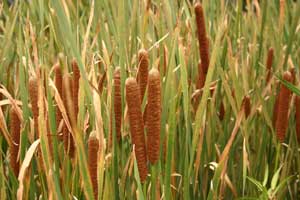This may not be exactly a gardening request, but someone may know something about ridding a pond of cattails.
We have a medium sized pond (used for watering cattle) and cattails are taking it over to the point that there is little water space left for our cattle to drink. Does anyone have a solution to help us get rid of these? Thanks for any help given.
Hardiness Zone: 6b
Karen from Gainesville, MO
Karen,This is a tricky question-and my answer is based on a few assumptions. First of all, I'm going to assume that your cattle have full access to the pond, meaning they can enter it from any where along the pond's perimeter. You didn't say whether or not this pond was built for your cattle, or if it's a natural pond. I'm going to assume that your pond isn't a protected wetland and that it doesn't contain fish. If it is protected or it contains fish, you'll need to check with your state's Department of Natural Resources regarding wetland regulations before you alter the pond's vegetation in any way. This isn't just to protect the pond, but also to protect you from possible future litigation.
Cattails are a vital part of a pond's ecosystem, so you don't want to get rid of all of them. One of the things they do best is purify the water, which of course is great news for your cows. Cattails spread by seeds or through their root system. Under the right conditions, they can rapidly take over and crowd out other important aquatic vegetation. All they need is sunshine and water that is 1 to 1 1/2 feet deep. Controlling their spread will probably require a combination of one or more of the following:
Hand-pulling: Grab young cattails by the roots and pull them out slowly. You can actually clear out an area of new growth pretty quickly this way because new growth pulls out easily. The leaves and roots can be chopped up and composted.
Cutting: You need to do this at the right time of year in order to be effective. Cut the cattails in late summer and you should only have to cut them once during the growing season. Use a shears or other non-electrical cutting tool. Cut the leaves down to below the water line. This will deprive the roots of food and reduce their ability to survive the winter. If done at the right time of year, you should see a noticeable reduction in cattails the following season. Do NOT cut cattails in the spring or you'll only stimulate more growth. Waiting until winter is too late because the roots have already stored their food reserves. Make sure you remove any cut leaf debris from the pond. If local ordinances allow it, you can also try burning the leaves down to the water's surface.
Flooding: Once you clear some of the cattails away, try filling the pond up with more water. Cattails will not re-establish themselves in water more than a few feet deep.
Limiting Access: Ironically, your cows may be adding to the problem, especially if they have unrestricted access to the pond. Damage to the pond's banks caused by trampling and over-grazing will encourage the cattails to spread even faster. Wading cows muddy the water. This lowers the pond's productivity by creating low dissolved oxygen conditions, which in turn kill off aquatic plants and animals that help keep the growth of cattails in check. Excess nutrients from cow manure also lower the water's dissolved oxygen and have the same effect.
Consider limiting your cattle's access to just one part of the pond. You can do this by fencing off an area and creating a water ramp that limits their access to the pond. The ramp can be covered with a geotextile filter fabric and some crushed stone to provide them with a walking surface that doesn't muddy up the water. Another idea is to limit their access completely by moving water out of the pond to a different area for drinking.
Good Luck!
Ellen

About The Author: Ellen Brown is our Green Living and Gardening Expert. Click here to ask Ellen a question! Ellen Brown is an environmental writer and photographer and the owner of Sustainable Media, an environmental media company that specializes in helping businesses and organizations promote eco-friendly products and services. Contact her on the web at http://www.sustainable-media.com
Add your voice! Click below to answer. ThriftyFun is powered by your wisdom!
Do some internet research on "grass carp". I know some farmers in this area use them to clear out plant growth in their ponds. I believe cattails are hard to get rid of but I think it would be worth trying the grass carp.
Where would a person find "grass carp"?I too have a pond that is over run with cattails!!
I'm not sure where you can buy grass carp in other states. In the state of Missouri you can contact the Missouri Department of Conservation in Jefferson City, Missouri. Other states may call their department something different (but similar).
Your local MFA or feedstore should be able to get you grass carp when they do their fish day... coming up in September here in Missouri. I don't know if they get rid of cattails, but they get rid of coonstail, so it is good to have a few in each pond. Get the hybrid kind that don't breed so they don't take over your pond.
Did you know you can eat the tender root of a cat tail. In case you ever want something different.
I heard somewhere where grass carp will not help the cattail situation.
Add your voice! Click below to answer. ThriftyFun is powered by your wisdom!